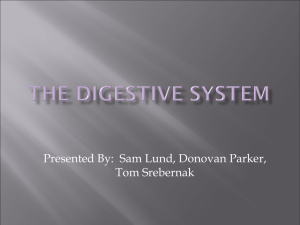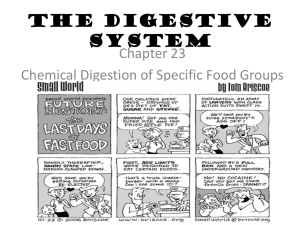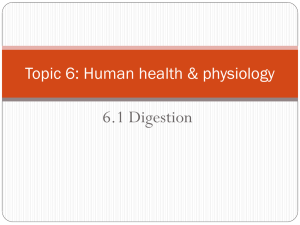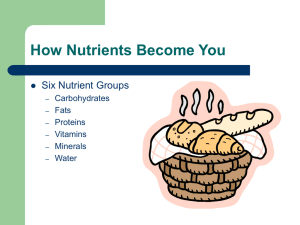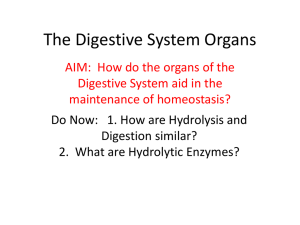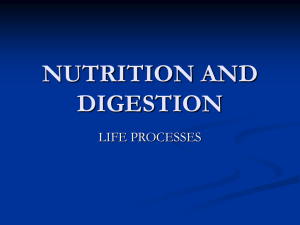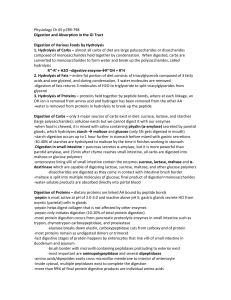Digestive and absorptive functions of the gastrointestinal system
advertisement
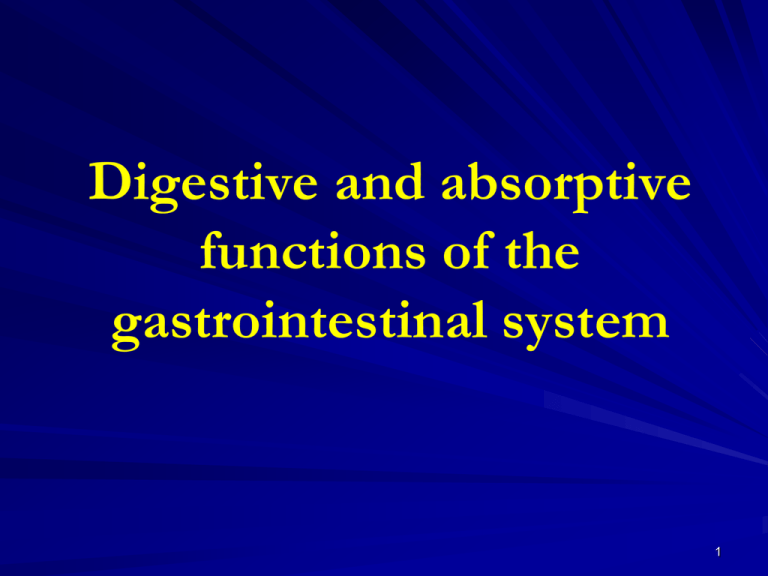
Digestive and absorptive functions of the gastrointestinal system 1 Objectives Describe the mechanical and chemical digestion of the stomach. Describe the digestion and absorption of carbohydrates. Describe the digestion and absorption of protein. Describe the digestion and absorption of lipids. Describe the absorption of electrolytes, and water-soluble vitamins, including the role of intrinsic factor in the absorption of vitamin B12. 2 Primary foods on which the body lives: Carbohydrates Fats Proteins + vitamins, minerals Cannot be absorbed in their natural forms—must be digested 3 Digestion of Carbohydrates 3 major sources of carbohydrate in food Sucrose----- disaccharide, cane sugar Lactose------disaccharide, milk Starch--------polysaccharide, non-animal food eg. Potato and grains Cellulose Essentially all the carbohydrates in the food are absorbed as monosaccharide and very small amount as disaccharide 4 Digestion of CHO in mouth and stomach Salivary amylase hydrolyses starch into maltose (trisaccharide) and glucose polymers In the stomach continue to digest CHO before mixing with gastric juice Accounts for 20-40% of CHO digestion 5 Digestion of CHO in small intestine Digestion by pancreatic amylase Very powerful amylase, virtually all the CHO will be digested into maltose and very small glucose polymers Digestion by Intestinal Epithelial enzymes Intestinal microvilli brush border contain enzymes that split disaccharides and glucose polymers into monosaccharide. Glucose represents more than 80% of the final products of CHO digestion Lactose splits into glucose and galactose by lactase enzyme Sucrose splits into fructose and glucose by sucrase enzyme Maltose and glucose polymers splits into glucose by maltase and dextrinase enzymes 6 Digestion of ProteinsProtein digestion in small Dietary proteins are chemically long chains of amino acids bound by peptide linkages Protein digestion in the stomach Pepsin (Recall from previous lecture) Pepsin important in digesting collagen. why? 10-20% of total protein digestion intestine Protein digestion by pancreatic enzymes Most of the protein digestion results from action of pancreatic enzymes Trypsin, chemotrypsin, carboxylpolypeptide, elastase Protein digestion by small intestine enzymes Digestion at the brush border of the enterocytes Aminoplpypeptidase and dipeptidase Digestion inside the enterocytes 7 Contain multiple peptidases Digestion of lipids (fat) The most abundant fat in the food is triglycerides Triglycerides composed of glycerol and 3 fatty acid molecules Digestion by salivary lipase and stomach lipase is limited (<10%)and generally unimportant Essentially all fat digestion occur in small intestine 8 Digestion of lipids (fat) First step in fat digestion is emulsification of fat with bile acids and lecithin in the duodenum. Lipase enzyme is water soluble and can attack fat globules on their surfaces. 9 Digestion of lipids (triglycerides) by pancreatic lipase The most important enzyme in triglycerides digestion is the pancreatic lipase enzyme. Triglycerides will be digested into free fatty acids (long and short chain) and 2 monglycerides 10 Basic principles of gastrointestinal absorption Small intestine is the major area of absorption (90%) Stomach is a poor absorptive area (highly lipid soluble substance and aspirin) 11 Absorption of Carbohydrates Essentially all CHO are absorbed in the form of monosaccharides 80% glucose 20% fructose and galactose All monosaccharides absorbed by active transport. Glucose transported by sodium co-transport mechanism Galactose similar to glucose Fructose transported by facilitated diffusion 12 Absorption of Proteins Most proteins are absorbed through the luminal membrane of the intestinal epithelial cells in the form of dipeptide, tripeptide and amino acids Transported by active transport. 13 Absorption of lipids All dietary lipids absorbed by simple diffusion Short chain free fatty acids Hydrophobic and very small size Pass through enterocytes by simple diffusion then to blood Long chain free fatty acids and monoglycerides Hydrophobic, large size Form micelles with bile salts (Micelles are composed of central fat globule (containing monoglycerides and long chain free fatty acids) with molecules of bile salts projecting outward to cover the surface of micelle) 14 Absorption of lipids cont.. Micelle carry monoglycerides and free fatty acids to enterocytes brush border. Monoglycerides and fatty acids diffuse out of micelle into the enterocyte. Inside enterocyte, monoglyceride and fatty acids are recombined to form triglycerides along with protein, phospholipids and cholesterol to form chylomicrons. Chylomicrones leave the enterocytes via exocytosis. Chylomicrones enter lymph then to the blood 15 Blood 16 Absorption of water Water absorption is entirely by simple diffusion (osmosis) Water can move across intestinal membrane in both directions to maintain osmotic equilibrium with blood 17 Absorption of Electrolytes Sodium is actively transported Negative charged ions chloride, iodide, bicarbonate and nitrate passively follow sodium absorption. Calcium actively transported in a process stimulated by vitamin D. Iron is actively transported. 18 Absorption of Vitamins Fat soluble vitamins (A, D, E, K) Included with ingested dietary lipids in the micelles and absorbed via simple diffusion Water soluble vitamins and vitamin C Absorbed via simple diffusion Vitamin B12 combined with intrinsic factor secreted by stomach and then absorbed in the ileum via active transport mechanism 19 Large Intestine Absorption of water and electrolytes Storage of fecal matter 20 Large Intestine • Contains no Villi: all the work of digestion and absorption is already accomplished in the small intestine. • Secretes mucus: to protect epithelial cells from excoriation and to provide adherent media for holding feces together. • Secrets HCO3-: to neutralize the acid secreted by colonic bacteria. • Its bacteria synthesize Vit K: what we eat is never enough. • Absorbs fluid: The proximal part. The longer feces remain the harder they become. • Stores feces: in the distal part until the conditions are right to defecate 21 Constituents of Feces Normally 75% water and 25% solid Indigestible material Some inorganic material (e.g. calcium and phosphate) Bacteria Stercobilin and urobilin → give the color of feces 22
